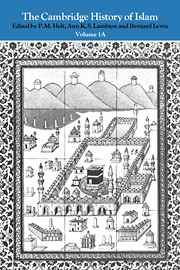Book contents
- Frontmatter
- Introduction
- Part I The rise and domination of the Arabs
- Part II The coming of the steppe peoples
- Part III The central Islamic lands in the Ottoman period
- 1 The rise of the Ottoman empire
- 2 The heyday and decline of the Ottoman empire
- 3 The later Ottoman empire in Rumelia and Anatolia
- 4 The later Ottoman empire in Egypt and the fertile crescent
- 5 Safavid Persia
- 6 Persia: the breakdown of society
- 7 Central Asia from the sixteenth century to the Russian conquests
- Appendix The Golden Horde and its successors
- 8 Tsarist Russia and the Muslims of central Asia
- References
2 - The heyday and decline of the Ottoman empire
from Part III - The central Islamic lands in the Ottoman period
Published online by Cambridge University Press: 28 March 2008
- Frontmatter
- Introduction
- Part I The rise and domination of the Arabs
- Part II The coming of the steppe peoples
- Part III The central Islamic lands in the Ottoman period
- 1 The rise of the Ottoman empire
- 2 The heyday and decline of the Ottoman empire
- 3 The later Ottoman empire in Rumelia and Anatolia
- 4 The later Ottoman empire in Egypt and the fertile crescent
- 5 Safavid Persia
- 6 Persia: the breakdown of society
- 7 Central Asia from the sixteenth century to the Russian conquests
- Appendix The Golden Horde and its successors
- 8 Tsarist Russia and the Muslims of central Asia
- References
Summary
Süleymān the Magnificent
Süleymān the Magnificent and Charles V
When Süleymān the Magnificent came to the throne on 17 Shawwāl 926/30 September 1520, he, like his ancestors, had to prove himself in the field of ghazā. This was the standard way of consolidating the power of a new sultan. Selīm's conquests had enlarged the empire to twice its size and inspired despair in Europe. Selīm had aimed above all at winning a great victory in the West. With this end in view he started building a great shipyard in Istanbul as early as 921/1515. Mehmed the Conqueror had been checked at Rhodes, the gate to the Mediterranean, and before Belgrade, the gate to central Europe. The pursuit of the ghazā in the West depended on the capture of these two fortresses of Christendom. Charles V ascended the Habsburg throne in 925/1519 and soon after, in Rabī‘ II 927/March 1521, the inevitable war broke out between him and the other great Christian ruler, Francis I of France. Europe was thus divided into two camps, and the idea of launching a united European crusade against the Ottomans became impracticable. The Ottomans could not have hoped for a more favourable set of circumstances. It was in these conditions that Süleymän began his reign.
- Type
- Chapter
- Information
- The Cambridge History of Islam , pp. 324 - 353Publisher: Cambridge University PressPrint publication year: 1977



